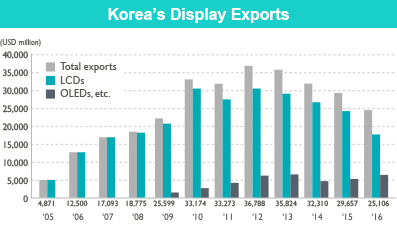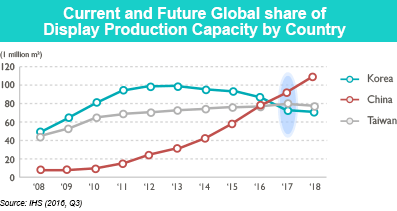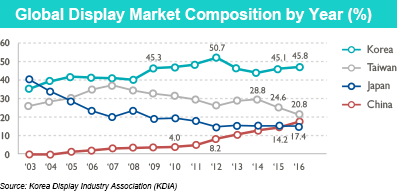
The display industry has grown swiftly in recent years,
powered by rapid development of television and smartphone makers.
During this time, Korea has maintained its position as the largest
display manufacturer in the world. Thanks to growing demand
from television and its related industries, the world’s display
industry also quickly expanded until 2012. The following year,
however, it began to contract due to the global economic recession, shrinking an average of 4.5 percent annually from 2012 to
2015. As the Korean display industry is number one in the world,
it is highly affected by such changes in the global market.
From the 2000s, displays started to emerge as a new export-
driven industry, contributing to the country’s economic growth.
Exports grew exponentially, recording an average annual rate of
27.7 percent from 2006 to 2010. In 2013, however, the global
economic downturn and oversupply pushed export growth down
to -2.6 percent, and the figure has remained in the negatives until
2016.

LCD (liquid crystal display) panel exports—the main driver of
the display industry—reached USD 18.2 billion in 2015, a 14
percent decline from the previous year, and fell further by 24.6
percent in 2016. Exports managed to recover slightly in the first
half of 2017, with a 11.7 percent year-on-year increase. In contrast, OLED (organic light-emitting diode) exports increased by
24.1 percent to USD 6.9 billion in 2016. With OLEDs being
applied to an increasing number of smartphone screens, the global demand for OLEDs has surged. OLED exports increased by
an annual average of 26.3 percent from 2014 to 2016, and continue to grow at about 20 percent this year. Thus, the OLED industry
is highly likely to lead the growth in exports for the entire industry.

Korea first emerged as the world’s largest display manufacturer in 2002, a title formerly held by Japan. By actively responding
to the changing environment through technological expertise and
bold facility investments, Korea quickly succeeded in taking the
No. 1 spot in the global flat panel display market. Despite the
recent slowdown in production and exports caused by the global
economic recession and oversupply, Korea still holds the largest
share of the global display market thanks to its industrial competitiveness.
In an effort to secure production hubs targeting China’s local
market and other export destinations, Korean companies have
initiated mass production at their LCD panel factories in China
(Samsung in Suzhou, LG in Guangzhou) in 2013. But the greatest obstacle for Korean display exports is the rise of China, as the
country is producing its own products and relying less on Korean
displays. This trend is expected to continue for the foreseeable
future. Since China started to focus on expanding its display
industry, it is expected to overtake Korea in terms of LCD production capacity in 2017. China’s LCD production capacity was
10.5 percent of the global total in 2013, but is expected to rise to
35.1 percent in 2017, and 40.1 percent in 2018.
A noteworthy change in China is that local companies are
actively investing in 10.5th-generation panels, a field Korea has
yet to invest in. China’s BOE Technology Group has commenced construction of a 10.5th-generation LCD panel produc-
tion line in 2015, and expects to gain a competitive edge for
ultra-large TV screens. In the second quarter of 2018, the company aims to begin operations at the 10.5th-generation factory,
where it plans to make large panels for 65-inch or wider TV
screens. China Star Optoelectronics Technology (CSOT), a subsidiary of large home appliances maker TCL Corporation, has
also decided to invest in the world’s largest 11th-generation LCD
panel production line and begin production in 2019. Other Chinese companies
such as HKC Electronics and CEC Panda
Crystal Technology have started to invest in 11th-generation
facilities and equipment. As such, Korea and China are soon
expected to compete on an equal footing in the global LCD
industry.
In contrast, for OLEDs, which are currently emerging as a new
type of display for the post-LCD era, Korean companies have
already secured a dominant 95 percent of the global market. As
such, it is very likely that Korea will continue to lead the global
display industry for some time. Korean panel companies have
started to replace their main LCD products with OLEDs, and
have established plans to focus their investments on related technology.

First, the scale of Korea’s domestic display market is relatively
small, and approximately 84 percent of all its manufactured
products are exported. Estimates for 2016 show that exports
account for 91 percent of LCD and 70 percent of OLED products
made in Korea. As the rapid rise in OLED exports partially offset
the poor performance in LCD exports, the emergence of the new
product is confirming the strengths of displays as an exports
industry.
Second, the fact that the world’s largest and second largest display manufacturers are based in Korea is probably the greatest advantage of the country’s display industry. With the world’s two largest display manufacturers—Samsung Display and LG Display—being based in Korea, the domestic display industry’s highly competitive structure has been driving development. It is also contributing to the establishment of a favorable business environment. The competition between the two companies has accelerated investment in new product and technological development, thus contributing to the industry’s continuous growth.
Third, the presence of a strong network of upstream and downstream industries in the country offers companies the stability to carry out production activities and strengthens their competitiveness. Supported by a network of smartphone, telvision, home appliances, automotive and other highly-developed industries with a demand for displays, as well as the rapid development of key parts and display equipment fueled by the panel industry’s high level of competitiveness, Korea boasts an optimum environment. Challenges remain, however, including the need to strengthen the country’s technological prowess in display materials and equipment. While the rate of domestically produced materials and equipment has radically improved, the country still struggles to develop technologies for key materials and equipment, relying heavily on imports from Japan and other technologically-advanced countries.
With global display markets projected to witness modest
growth until 2020, OLED products are expected to drive growth
in the entire industry due to the soaring demand for OLED
screens for smartphones. Currently accounting for 95 percent of
the newly emerging global OLED market, Korea is expected to
enjoy the fruits of the global surge in demand for some time.
This is because it will take at least several years for its competitors in countries such as Japan or China to be able to mass produce OLEDs.
In 2015, OLED panels accounted for 10 percent of the global
display market, but the figure is projected to reach 25 percent by
2022. Currently, most OLED displays are used as smartphone
and TV screens, but the market is expected to expand greatly as
technology evolves to enable the production of flexible and
transparent OLED displays.
On the other hand, the share of LCDs is expected to continue
to decline, as the expansion of China’s LCD output acts as a
major obstacle to growth. While China is the world’s biggest
market for LCD panels, Chinese companies account for over 70
percent of the local TV market. Therefore, as the country continues to raise its LCD output, it seems there will be increasingly
fewer opportunities for Korean companies to supply LCDs to
Chinese TV companies.
In conclusion, although Korea’s display industry is expected to
encounter difficulties due to competition with China in LCDs, if
OLED panels start becoming a popular option for TV screens
and demand for OLEDs rises in the field of new convergence
technologies, Korea is expected to enjoy an even greater number
of opportunities for growth. As OLED markets continue to
expand, rival countries such as China, Japan and Taiwan will
also expand their investments. But because Korea has a clear
competitive advantage in mass production capacity and product
development over its rivals, it is expected to maintain a significant lead over its three key competitors until 2020.
The shift in the global industrial paradigm during the fourth
industrial revolution is expected to create new opportunities in
the display industry, as the demand for displays increases not
only for flexible screens, but also for wearable devices, smart
cars and smart homes. Should Korea’s display industry focus on
expanding OLED markets and accumulating related technology,
it is expected to strengthen its global dominance even in the new
markets of the future.
* The opinions expressed in
this article are the author's own and
do not reflect the view of KOTRA.